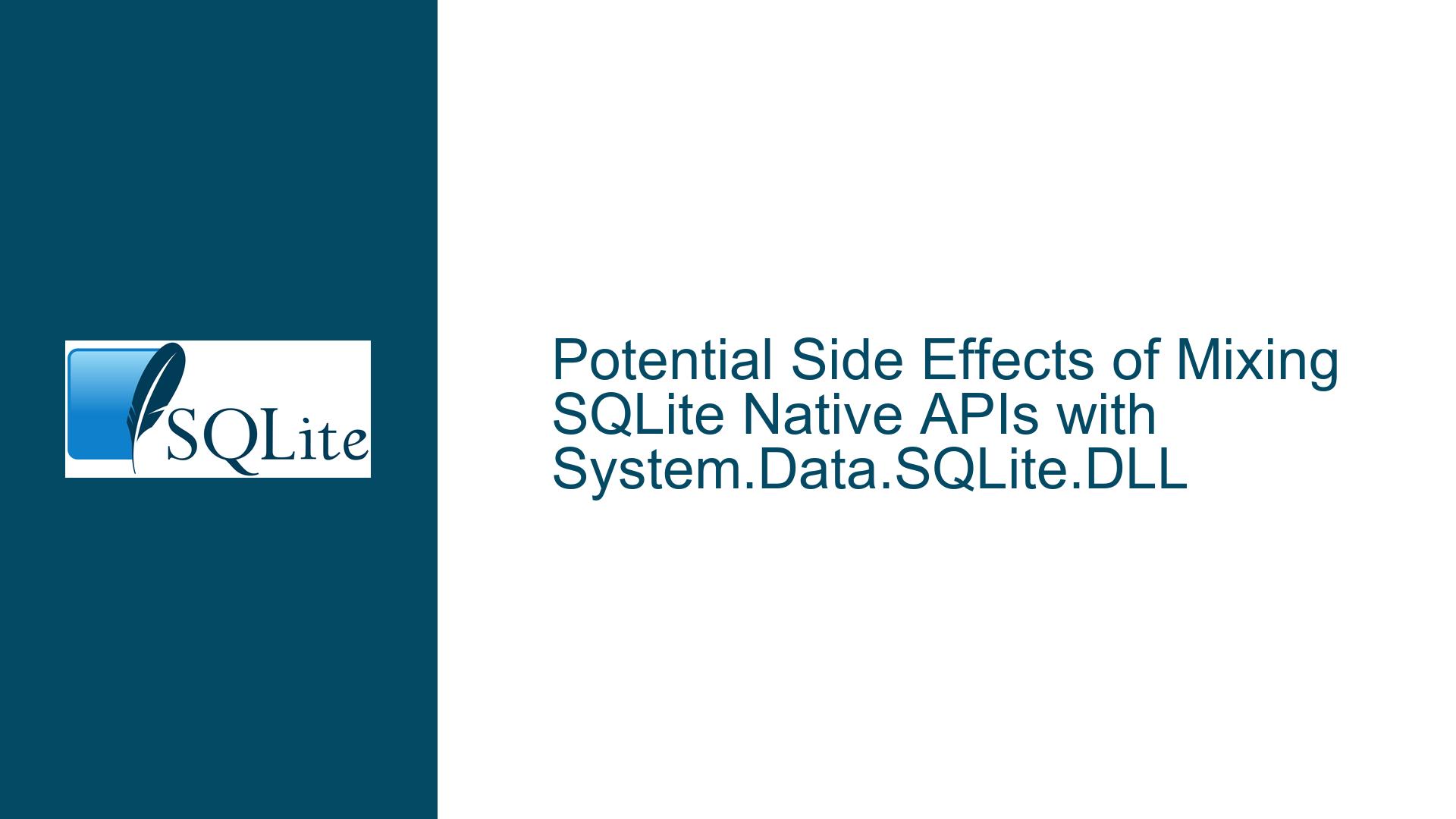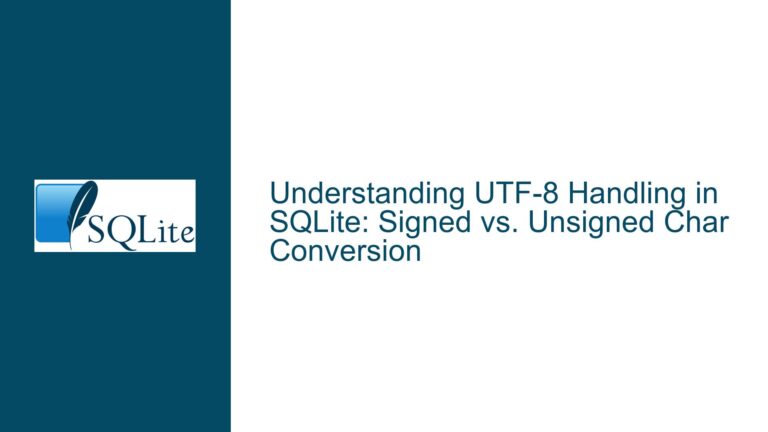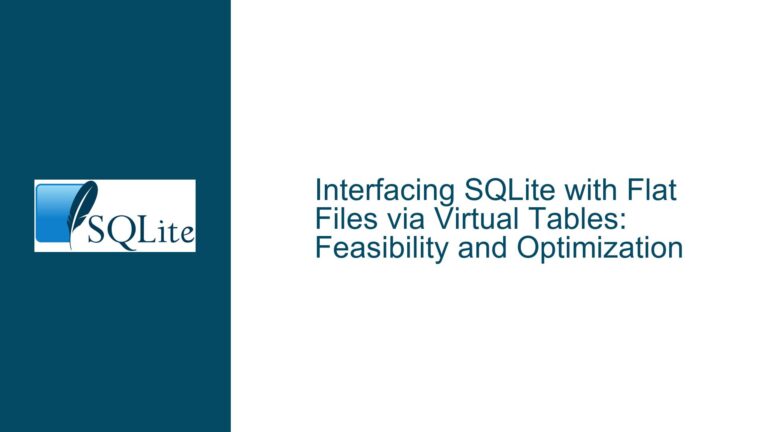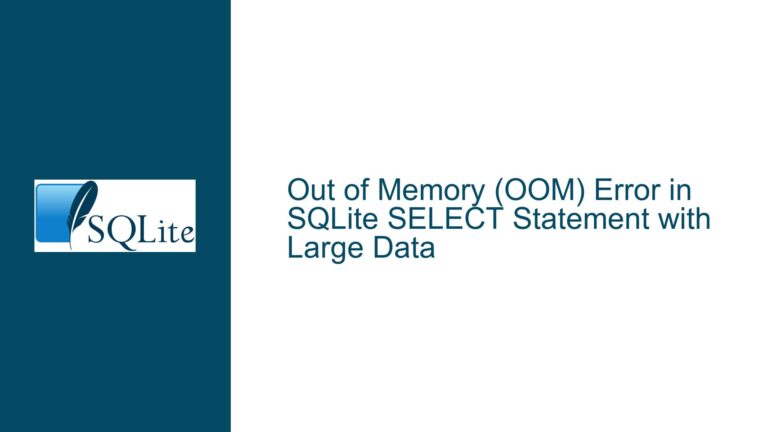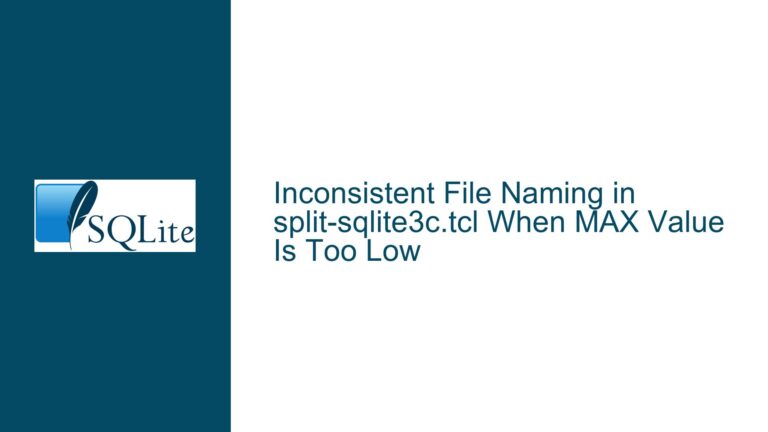Potential Side Effects of Mixing SQLite Native APIs with System.Data.SQLite.DLL
Interplay Between Native SQLite APIs and Managed System.Data.SQLite Wrapper
Issue Overview
The core challenge arises when developers combine direct calls to SQLite’s native C APIs (such as sqlite3_open or sqlite3_open_v2) with the managed .NET wrapper System.Data.SQLite.DLL. While SQLite’s native layer provides low-level control over database operations, System.Data.SQLite.DLL abstracts these details into a managed object model compliant with ADO.NET conventions. The friction occurs because these two layers operate under fundamentally different execution contexts:
Native vs. Managed Resource Ownership:
System.Data.SQLite.DLLinternally wraps SQLite’s native APIs to manage connections, transactions, and statements. When developers directly invokesqlite3_openoutside this wrapper, they create database handles (sqlite3*) that the managed layer is unaware of. This duality risks scenarios where resources (memory, file locks, prepared statements) are managed inconsistently. For example, a connection opened natively might not respect the connection pooling strategy implemented bySystem.Data.SQLite.Global State Contention:
SQLite’s configuration settings (e.g., memory allocation hooks, error logging, or mutex behaviors) are global. IfSystem.Data.SQLite.DLLinitializes SQLite withsqlite3_configduring assembly load, subsequent native API calls might inadvertently alter these settings, destabilizing the managed layer. This is especially critical for multi-threaded applications where the managed wrapper assumes control over threading modes viaSQLITE_OPEN_NOMUTEXorSQLITE_OPEN_FULLMUTEX.Function Collisions and Version Mismatches:
TheSystem.Data.SQLite.DLLlibrary often ships with a specific version of SQLite amalgamation compiled into it. Directly linking against a different version of the native SQLite library can lead to undefined behavior due to ABI incompatibilities. For instance, if the native layer uses SQLite 3.45.1 while the managed DLL embeds SQLite 3.40.0, features like JSONB support or new virtual tables may behave unpredictably.Memory Leaks and Dangling Handles:
Managed objects inSystem.Data.SQLite(e.g.,SQLiteConnection) rely on finalizers to release native resources. If a nativesqlite3*handle is opened directly and not explicitly closed withsqlite3_close_v2, the garbage collector cannot track it, leading to resource leaks. Conversely, closing a handle managed by the wrapper through native APIs can cause access violations.
Root Causes of Instability When Combining Native and Managed Layers
Uncoordinated Initialization Sequences
The managed System.Data.SQLite.DLL initializes SQLite’s engine implicitly when the first connection is opened. This initialization configures memory allocators, mutex subsystems, and extension loading. If a developer invokes sqlite3_open_v2 before this implicit initialization, the native layer may use default configurations that conflict with the managed layer’s expectations. For example, if the native call enables shared cache mode via SQLITE_OPEN_SHAREDCACHE while the managed layer assumes private cache mode, concurrent transactions may deadlock.
Flag Mismatches in Database Connections
The sqlite3_open_v2 function accepts flags (e.g., SQLITE_OPEN_READWRITE, SQLITE_OPEN_URI) that determine connection properties. System.Data.SQLite translates .NET connection strings into these flags. When bypassing the wrapper, developers might omit flags that the managed layer depends on, such as SQLITE_OPEN_EXRESCODE for extended error codes. This can lead to inconsistent error handling—native APIs might return raw error codes that the managed layer cannot interpret correctly.
Unmanaged-to-Managed Transitions Without Marshaling
Passing native SQLite objects (like sqlite3* or sqlite3_stmt*) into managed code requires careful marshaling. System.Data.SQLite.DLL uses opaque wrappers (e.g., SQLiteConnection.Handle) to safely reference native resources. Directly exposing pointers to managed code risks premature garbage collection or type mismatches. For example, casting a native sqlite3* to IntPtr and wrapping it in a SQLiteConnection could bypass critical initialization steps performed by the managed wrapper’s constructor.
Extension Loading Conflicts
SQLite extensions (e.g., full-text search or cryptographic modules) are often loaded via sqlite3_load_extension. The managed layer provides mechanisms like LoadExtension within SQLiteConnection. If extensions are loaded natively, the managed layer might not account for their presence, leading to missing function errors in LINQ queries or Entity Framework operations. Worse, native-loaded extensions might not adhere to the managed layer’s security policies, such as disabling untrusted extensions.
Transaction Scope Ambiguities
System.Data.SQLite.DLL integrates with ADO.NET’s transaction system, mapping BeginTransaction() to SQLite’s BEGIN IMMEDIATE. If a native API starts a transaction using BEGIN EXCLUSIVE, the managed layer’s attempt to escalate transaction levels might collide, resulting in SQLITE_BUSY errors. This is exacerbated when using the same connection handle across both layers—a practice that is inherently unsafe due to differing lifetime management rules.
Mitigation Strategies and Architectural Best Practices
Unified Initialization and Configuration
Ensure that all SQLite interactions route through System.Data.SQLite.DLL during the application’s startup phase. If native API usage is unavoidable, perform explicit initialization via sqlite3_initialize() before any managed operations and align configuration flags with those expected by the managed wrapper. For example:
// In managed code, force early initialization
using (var conn = new SQLiteConnection("Data Source=:memory:")) {
conn.Open(); // Forces SQLite engine init
}
// In native code (via P/Invoke)
sqlite3_open_v2("file:app.db?mode=rwc", out var db, SQLITE_OPEN_READWRITE | SQLITE_OPEN_CREATE | SQLITE_OPEN_URI, null);
This ensures the managed layer’s configuration (e.g., memory allocators) is primary.
Isolate Native and Managed Connections
Never share sqlite3* handles between native and managed code. Treat them as entirely separate domains. If data must cross layers, use intermediate formats like byte arrays or temporary disk files. For example, export a native-created table to a .csv file and import it via the managed layer’s bulk insert utilities.
Explicit Lifetime Management
When mixing layers, adopt a strict ownership model. Assign clear responsibility for closing handles:
// Managed code owns 'managedConn'
using (SQLiteConnection managedConn = new SQLiteConnection("Data Source=:memory:")) {
managedConn.Open();
IntPtr nativeHandle = managedConn.Handle; // Access via wrapper property
// Do NOT pass nativeHandle to sqlite3_close()!
}
// Native code owns 'nativeHandle'
sqlite3* nativeHandle;
sqlite3_open("file:native.db", &nativeHandle);
// ... use handle ...
sqlite3_close_v2(nativeHandle);
Version Alignment and Embedding
Compile System.Data.SQLite.DLL from source, linking it against the same SQLite version used in native components. This eliminates ABI mismatches. The SQLite consortium provides amalgamation flags for this purpose. Update all projects to reference identical sqlite3.h headers.
Diagnostic Instrumentation
Enable SQLite’s diagnostic features in both layers:
// Managed layer logging
SQLiteLog.Initialize();
SQLiteLog.AddLogger(new SQLiteConsoleLogger());
// Native layer logging (via P/Invoke)
sqlite3_config(SQLITE_CONFIG_LOG, (IntPtr)LogCallback, null);
[DllImport("sqlite3", CallingConvention = CallingConvention.Cdecl)]
static extern int sqlite3_config(int op, IntPtr arg, IntPtr dummy);
private static void LogCallback(IntPtr pUserData, int errCode, IntPtr pMessage) {
string message = Marshal.PtrToStringAnsi(pMessage);
Console.WriteLine($"SQLite Native Log: {message}");
}
Cross-reference logs to identify conflicting configurations or resource leaks.
Alternative Architectures
If tight integration is unavoidable, consider embedding the managed wrapper within a native host process. For example, run System.Data.SQLite.DLL in a .NET runtime hosted within a C++ application, using inter-process communication (IPC) to serialize database operations. This sandboxes each layer, preventing direct memory corruption.
Thread Affinity and Locking
Enforce that native API calls occur on the same thread where the managed SQLiteConnection was opened. SQLite connections are not thread-safe unless configured with SQLITE_OPEN_FULLMUTEX. Use System.Data.SQLite’s Synchronous=Off or Journal Mode=Memory pragmas to reduce contention points.
Code Auditing and Static Analysis
Use tools like sqlite3_trace_v2 and .NET memory profilers to trace cross-layer interactions. Validate that all native handles are closed explicitly and that no managed objects retain references to disposed handles.
By rigorously segregating layers or meticulously aligning their configurations, developers can mitigate the risks of combining native SQLite APIs with System.Data.SQLite.DLL. The overarching principle is to treat the managed wrapper as either the exclusive gateway to SQLite or a strictly isolated consumer—never as a peer to unmanaged code.
